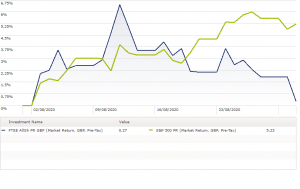Investment report 2nd September 2020
Most Markets have ended the month higher.
The following chart shows the US and UK market during July. The FTSE 100 represents the 100 largest companies in the UK and the S&P 500 represents the 500 largest in the US. The Dow Jones is often quoted but this only shows the top 30 companies and is dominated by technology companies.

I think the recent increase in the Dow Jones needs an explanation and this month’s report will focus on the US.
The US stock market has hit new highs in recent weeks, propelled by several of the largest companies in the Technology Sector, but also by companies that have benefitted from Covid-19 such as pizza makers Dominos and soap manufacturers Colgate, Palmolive and Unilever.
We have seen huge increase by companies that already dominate the US stock market – Apple is the first $2trillion company.
| % increase | |
| Alphabet (was Google) | 20.37 |
| Amazon.com Inc | 84.77 |
| Apple Inc | 74.72 |
| Facebook Inc A | 41.33 |
| Netflix Inc | 61.92 |
The majority of stocks are still down though – share prices of a fifth of the S&P 500 companies are more than 50% below their all-time highs as of the 21st of August 2020. The average stock is 28% below its peak. The concern of course is that such valuations in large companies, which drag the index up, cover the reality of what is going on in much of the economy.
This probably highlights more than anything else the vulnerability of the market recovery as any negativity surrounding the tech giants could bring markets crashing back down. The saving grace is that strong earnings do support most of these companies, it’s not a repeat of the late 1990’s tech bubble when valuations were built on unrealistic earnings forecasts.
This effect has also led to those stocks known as growth stocks being more highly valued than so termed value stocks. The S&P 500 growth index is up 11% while its value counterpart is down 13%.
Is growth in a bubble? The jury is out right now but the gap has opened up significantly and doesn’t look like closing anytime soon. The most recent Fed announcement, that they are prepared to let inflation creep ahead of targets, does give some optimism for value stocks such as banks, but isn’t the only shift that needs to happen to bring the returns of the two styles closer together.
The US investments within income producing portfolios tend to be biased towards Value and within growth portfolios I aim for a balance between both types of stock.
Whilst some clients may what Value and Growth terms mean I thought I would clarify the definition;
A Growth stock is any share in a company that is anticipated to grow at a rate significantly above the average growth for the market. These stocks generally do not pay dividends. This is because the issuers of growth stocks are usually companies that want to reinvest any earnings they accrue in order to accelerate growth in the short term. When investors invest in growth stocks, they anticipate that they will earn money through capital gains when they eventually sell their shares in the future.
A Value stock is a stock that trades at a lower price relative to its fundamentals, such as dividends, earnings, or sales, making it appealing to value investors. Common characteristics of value stocks include high dividend yield and/or a low Price/Earning ratio. A value stock typically has a bargain-price as investors see the company as unfavourable in the marketplace.
These comments are my own thoughts on the current outlook and in no way offer any guarantees.
As always, should you have any concerns you wish to raise, please do contact me.
We are working from the office more frequently, though not quite full time. The office is usually manned every morning but not all afternoons – still doing some tasks from home, where possible.
We are Covid ‘safe’ and therefore able to see clients in the office.

